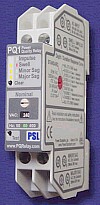|
"Power Quality Recorder: A device used to detect and then indicate to a user there has been a power quality transgression in the form of a transient, swell, or sag.
In a nutshell this is an "AC in - relay out" power quality detector with contacts that tell there's been a transient/swell, minor sag, and/or major sag. The "recording" part is formed of two elements, the first being LEDs showing there has been an event, the second being the outputs connected to anything from simple counters through to a SCADA system via I/O modules. Before I'm accused of misleading anyone, there is a little bit of configuring required before installing this little beast (oh yeah, here we go, software..), but this is done with a screwdriver (Gotcha!). There are two selectors that must be set being the nominal voltage, and the transgression curve most suited to the application. As for the curves, well, there is the usual CBEMA, ITIC, etc., but, and this impressed me, there is also a ZA (South African) curve! Those who have heard of 'African' power better believe there are times when the power dips to nothing for well over a half a second (not because the network is poor, far from it, but ever heard of lightning?). Uses for this device would be too numerous to mention here (the website is full of useful applications), although I would like to focus on one aspect being this is the ideal device to simply indicate here has been a power quality incident. It is perfect for the small to medium enterprises that rely on PCs and/or other hi-tech devices for their operation and want some form of power monitoring, but don't have the resources to afford the fully fledged PQ recorder. Costing even less than half the price of hiring reasonable gear for a week, it would be almost criminal not to permanently install this little beast in a distribution board as a stand-alone item (and as it is not on hire there isn't any fear of having to return it to the owner!). Even without connecting the outputs to anything, it is now keeping watch over transgressions that may affect hi-tech gear. Installing this device at an appropriate place will now allow the owner/tenant of the premises to differentiate whether it is power quality or other issues behind the cause of equipment problems or failure. Periodic investigation of the LEDs will signal whether or not there is need to call on more substantial monitoring equipment for the short term. Although designed for a distribution board, I mounted one in a simple ABS case fed with an IEC320 (computer) power socket. The outputs are coupled to three battery powered counter modules. The beauty of this new "instrument" is there is no need for any interfacing software yet maintains a count of power quality transgressions. What's more, any person can read it. As said on the previous page, there is an obvious shift required in standard thinking practices especially when viewing the PQRelay. When a specification states "..a power quality recorder shall be installed to record there has been a transgression of the specified power quality curve..", there is no need to think the expensive route. The PQRelay fits this portion of the requirement perfectly, at a fraction of the cost!
© 11.08.02 |
 MEASUREMENT TECHNIQUES:
MEASUREMENT TECHNIQUES: